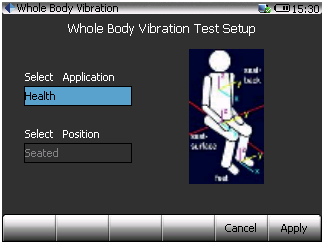Whole Body Vibration Analysis
Whole Body Vibration (WBV) testing is a type of vibration analysis geared towards estimating the effects on the operator. There are three categories of concern for the operator, health and comfort, perception, and motion sickness. The goal for any WBV test is to ensure that under normal operating conditions there is no significant or lasting effect of the vibration experienced by the operator.
A common application of WBV analysis is to evaluate vehicle vibration. Commercial drivers will spend several hours a day driving, exposed to road and engine vibration through the seat, floor and steering wheel. Excessive levels of vibration can cause fatigue and numbness in the back, feet, and hands. The ability to measure the vibration and estimate the effect of prolonged exposure to helps to reduce the possibility of injury.
Whole Body Vibration analysis is both application and position dependent. Motion sickness is caused by low frequency vibration with periods of 2 to 10 seconds (0.1 ? 0.5 Hz). Perception, and Health and Comfort measurements are evaluated from 0.5 ? 80 Hz. Depending on the application, up to three different body positions can be tested: seated, standing, and recumbent (laying). All of these variables play a role in the analysis of how long a person can safely operate under specific levels of vibration.
The amount of time someone is exposed to vibration is also critical to the analysis. In general, the vibration is very similar between a consumer vehicle and a commercial vehicle, the key difference is the average amount of time spent under those conditions. Consumer vehicles are generally used for shorter trips. An eight hour drive in a car would be considered a very long day. An eight hour shift for commercial drivers would be considered normal. This is why buses and semi-trucks usually have air suspension for the driver seat. The levels of vibration are similar, but the duration of exposure is much longer.
(For step-by-step instructions on how to conduct modal testing on the CoCo instruments, click here to download the CoCo Modal Data Acquisition Operation Manual.)
Whole Body Vibration Testing
Measurements for Whole Body Vibration testing require triaxial data in nearly all testing locations. For this example we will look at a basic WBV test to evaluate health risks. Analysis for health applications are concerned with seated persons and the vibration from 0.5 Hz to 80 Hz. Vibration in this bandwidth can cause disruptions to the functioning of the spinal column and associated nervous system, as well as potentially disrupting the digestive system.
Figure 1: Introduction page for Whole Body Vibration analysis
Vibration needs to be measured at the transfer point between the seat pad and the spine. Special accelerometers are produced to accommodate mounting on a seat pan with minimal disturbance to the operator (see Figure 2). The seat pad accelerometer should be placed directly below the ischial tuberosities, or sitting bones.
Figure 2: Triaxial seat pad accelerometer
Measurements need to be made for enough time to provide reasonable statistical precision. The duration will depend on the type of analysis performed and the bandwidth of interest. For this example, the lowest frequency of interest will determine the amount of time needed. For Health applications, the bandwidth is 0.5 Hz to 80 Hz. To measure 0.5 Hz with an error of less than 3dB and a confidence of 90% a test would need to be at least 227 seconds (source: ISO 2631-1:1997).
Test conditions, application, orientation, sensor placement, and test duration should all be reported to evaluate the results of the test.
There are currently no quantitative values to characterize acceptable levels of vibration.
The following equipment is required to perform a Whole Body Vibration test:
A triaxial accelerometer, preferably one that lends itself to being attached in an unobtrusive way.
Performance criteria.
Whole Body Vibration Analyzer Settings for Modal Testing
The following settings are used for impact hammer modal testing.
Application: The applications for Whole Body Vibration analysis are Health, Comfort and Perception, and Motion Sickness. Health and Comfort and Perception applications measure vibration from 0.5 Hz to 80 Hz and apply filters that help mimic the amount of energy is transferred to the human body. Motion Sickness tests are concerned with lower frequency vibration from 0.1 Hz to 0.5 Hz.
Position: The position of the operator is important to Whole Body Vibration analysis. Three positions are outlined in WBV standards, Seated, Standing, and Recumbent (laying).
Time Hold: This setting specifies how long the test will run. The duration of tests are flexible, but they must be noted to extrapolate the readings to the length of exposure in normal operating conditions.
Calculate Method: In addition to the basic analysis two optional types of calculations can be performed. The running RMS method uses similar methods as the basic analysis but is designed to show the effects of shock events during the test. The running RMS method results in the maximum transient vibration value (MTVV). The Fourth Power Vibration Dose Value (VDV) is more sensitive to peaks than the basic evaluation.
Recommended for Whole Body Vibration Testing
The CoCo-80X (and CoCo-90X) dynamic signal analyzer and vibration data collector are recommended by Crystal Instruments for Whole Body Vibration testing. The CoCo series feature an intuitive interface, 2 to 16 channel configurations, and excellent product support to guide users through all their testing needs.


